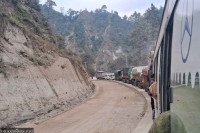Opinion
Company of wolves
The concerned communities should be involved in the wolf conservation
Chun Bahadur Gurung
Wolves do not just howl and growl in the distance, but stalk and hunt domestic animals such as horse, which costs almost Rs100,000, and further weakens the poor economy of the people in the Himalayan region. So people deeply consider wolves as their greatest ‘foe’ and yearn to exterminate them. There is a system, which has become a ritual in these areas, to felicitate huntsmen and hunters who slay wolves. Thus, they directly undermine wolf conservation measures. The conservationists, however, recently concluded a ‘wolf-talk’ in Kathmandu regarding wolf conservation. As for the Himalayan inhabitants, talks about wolf conversation are just a natter.
Friend not foe
However, the researchers Raju Acharya and Yadav Ghimirey, who have recently concluded a research project on wolves in the Annapurna area, depict wolves as farmers’ friends as there are well-documented cases that the number of livestocks claimed to be killed by wolves is frequently exaggerated. While releasing the research report, Acharya emphasised the inevitable interrelationship between human beings and ‘members of the wolf family’. He reiterated that the wolf is the best indicator of a complete food-chain in the ecosystem cycle and that it is an intelligent and resilient predator of other prey species that destroy farm crops. The young conservationists strongly made their point that wolves in fact, are “farmer’s friends” as they hunt cattle and other livestocks only when they do not get their prey in the jungle. Further they prey on diseased and infected animals. There is growing evidence that wolves—by getting rid of sick animals—improve the overall health of prey species.
Referring to a case of Yellow Stone National Park of the US, Acharya said, “The sharp reduction in the number of wolves helped in the rise of the Moose’s number and there were unpleasant impacts on the existing flora composition in the area.” A research paper by Dr. Paul Haeming also confirms that, “Wolves cause a dramatic decline in the number of foxes.” He further referred to the case of Stockholm region and stated, “Where wolves have been exterminated, there has subsequently been a large increase in the number of red foxes.” As a result, it severely weakens the food chain.
Regrettably, people poach wolves and use its organs for medical treatments, including cancer care and arthritis medication, in Nepal. This practice, however, is based on age-old beliefs and conventional practices and not yet endorsed by medical science. Despite this research, what makes the situation bizarre in relation to wolf conservation is that no assessment has been undertaken to find out the actual number of wolves in Nepal. According to Dr Ghanashyam Gurung, a noted conservationist, Nepal’s wolf population was significantly decimated by hunters during the Khampa insurgency; it was nearly nil. Luckily, we can spot it in Nepal as a result of its survival in the Tibetan territory. A ballpark estimate is that only 30-50 wolves exist in Nepal.
What is interesting to note is that it is still unknown which species of wolves are present in Nepal. Nevertheless, the government does acknowledge human-wolf interrelationship and has legally classified it as a ‘protected’ wildlife under the National Park and Wildlife Conservation Act 1973. It makes wolf hunting illegal under the Article (9) of the same Act. However, enactment of the Act alone is not enough to save the critically endangered creature.
Shedding light on the local context, Dr Gurung candidly said, “Simply discussing wildlife conservation is just chitchat. If we need to protect, at the very least, a vestige of the wolf’s population, we also need to emphasise the wolves-human interrelationship.” His prescription was loud and clear: Ethics as a core value in conservation. In the absence of ethics in the field of conservation, all wild lives, particularly critically endangered ones, could one day become mythical species.
Exisiting gaps
Unfortunately, Kathmandu—a concrete jungle—is far from the wolf’s habitat and conservationist must go back to the jungle and nearby villages to protect the habitat. But merely protecting the habitat might not be enough to save the wolves. As people living near the areas where wolves reside want to remove them completely, it is imperative to team up with them. While the wolf’s ‘enemies’ in the villages will be delighting in the sheer decline in its numbers, it will in fact contribute to the deterioration of the ecosystem and severely impair the food chain—something that they need to be aware of.
What is nearly ignored in the wolf conservation crusade is an appropriate communication blueprint, its effective implementation and formulation of other strategies to cope with the challenges. One of the participants of the ‘wolf-talk’ urged that the District Public Health Office, for example, has to be on board as a key conservation partner since the medicinal values of wolf-organs have been identified as one of the key motives behind wolf hunting. But considering the wolf’s critical role in the ecosystem cycle, conservationists and authorities need to persuade, with effective communication, the concerned community members, who can make a real difference.
Gurung is a former spokesperson for the Office of the UN High Commissioner for Human Rights, Nepal




 13.98°C Kathmandu
13.98°C Kathmandu












